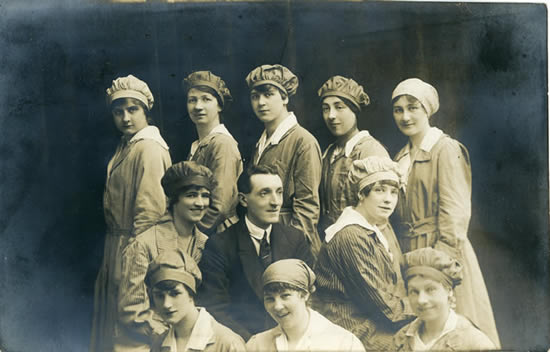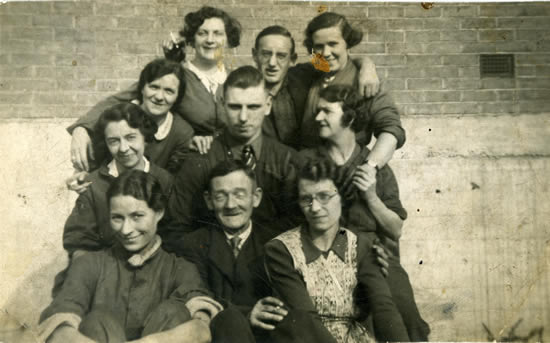Women At War
Newport women carried out many jobs in the town when their men were at war.
By Jim Dyer
First published in the South Wales Argus1987
© Jim Dyer 2012
Turbans seemed to be the fashion well into the 'fifties I noticed when I was young. This was a product of the war, to protect the ladies’ long hair getting tangled in machinery. These were the girls who kept industry going when the men were at war.

Munitions workers, First World War. A White House Studios, Newport, Mon postcard.
When Mrs Pankhurst, the suffragette leader, visited Newport in 1909 she could never have foreseen the two world wars which would play a major role in changing the part of women at work. Vast numbers of women took men's jobs in the First World War and when the second broke out thousands of them became industrial conscripts.
Women at Work
Able bodied men were released to fight while women took over production for the wartime economy in munitions, shops, offices, agriculture and public transport. By 1939 a quarter of engineering workers in munitions were women and by 1942 the figure was well over half.
And out of work? A man told me, 'Many of them visited 'Pearl Harbour' – The Westgate – because of the many American servicemen who frequented it. They really enjoyed themselves. They frightened me to death!'
It is understandable that the hard-working ladies needed to relax after a hard day at the hot lathe! They worked at places like Stewart and Lloyds, Royal Ordnance Factory or Godin's, or even further afield at Lucas, Cwmbran.
A former woman worker said, 'I worked at Godins' for a while on three shifts. It was hard going but there was a great atmosphere on the shop floor and always a laugh or two.' Another cheery lady said, 'My husband worked down at the factory as well and we had an evacuee from London staying with us. She worked there too.'

Workers at Godins, Second World War.
Many of the women proved versatile workers and didn't limit themselves to working at one factory. One told me she started at Godins went on to Stewart and Lloyds, transferred to making gun turrets at Lucas and ended-up at the Stocking Factory in Portland Street.
Stewart and Lloyds was particularly well remembered. 'We used to make shells from six to twenty-four pounds. I did all the jobs from roughing (cutting to size) up to making copper bands for the shells.'
Some key male workers remained and each fitter had a mate, a woman. Many of the fitters were remembered as wags. One walked around with a box of swarf from the metal offering the women 'fish and chips'. Another did a rendition of playing tunes on the lines of stacked shells, his best being 'Blueberry Hill.'
Dangerous Work
In 1940 the Factory Inspector reported and increase of over 24% in fatal accidents from 1939 and a 20% jump in non-fatal ones. A worker recalls, 'I was working a lathe smoothing copper and the file caught in the chuck. It badly damaged my face and I had to go to hospital. The Union tried but I never got compensation.'
At Lucas, a girl's clothes were stripped from her when they caught in the machine and she was lucky to be alive.
To keep morale high music was played constantly and there were lunchtime shows and dancing. Sometimes the girls put on their own shows. 'I'll never forget,' said one. 'Girls used to dress up as Old Mother Riley, we had a Flannagan and Allen sketch but most of all we loved to dance.'
When the war ended the girls returned to their peacetime roles. Many Newport homes still have a shell or two on their mantlepieces, now converted to lighters, neatly packed with cotton wool and flint mechanisms.
It's remarkable to think these women who worked so hard had also to cope with rationing, running homes and raising families.

Women worked at places like Stewart and Lloyds, Royal Ordnance Factory or Godin's,
or even further afield at Lucas, Cwmbran.
Jim Dyer – 1st January 2012
NOTE
Published in South Wales Argus – 19th Feb 87